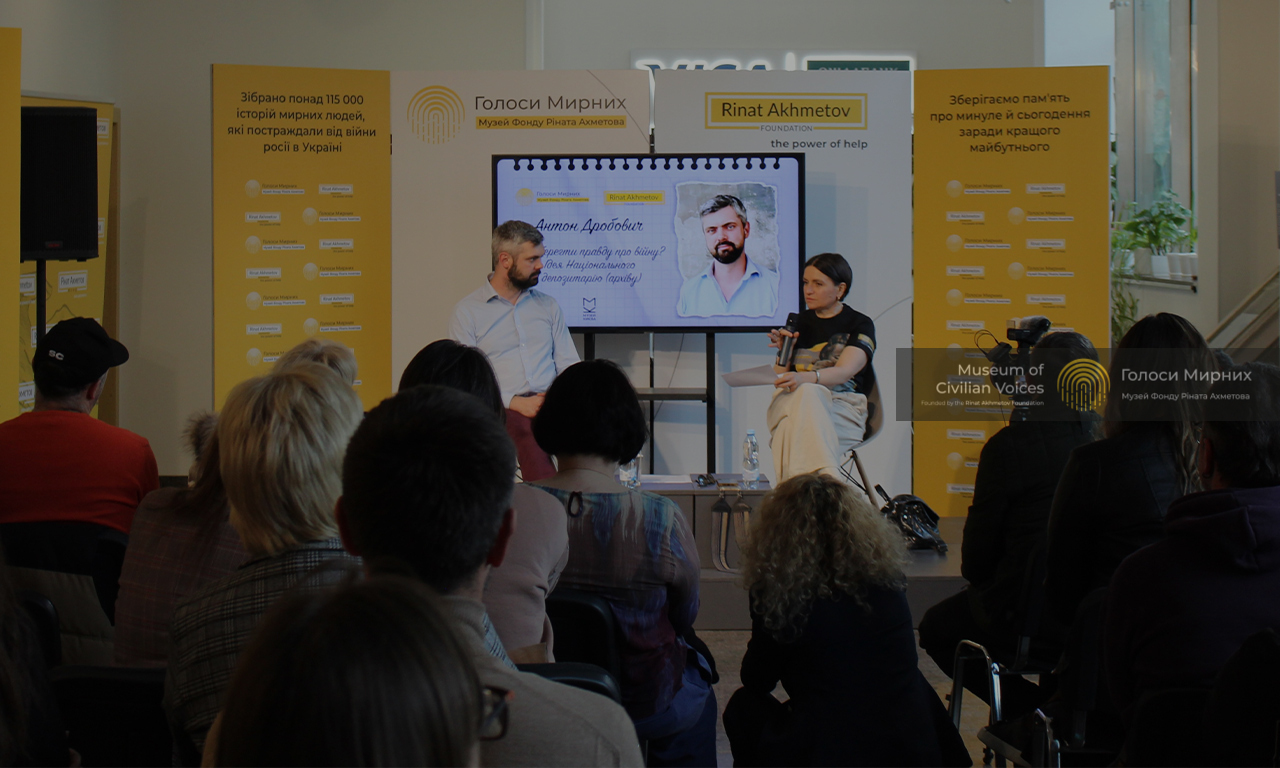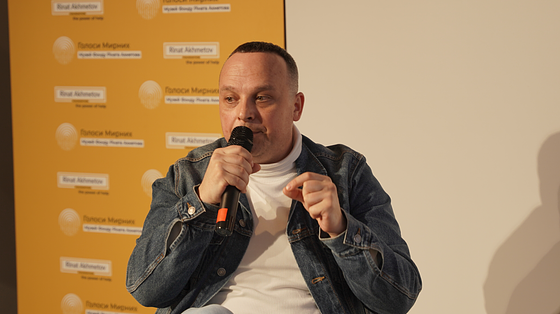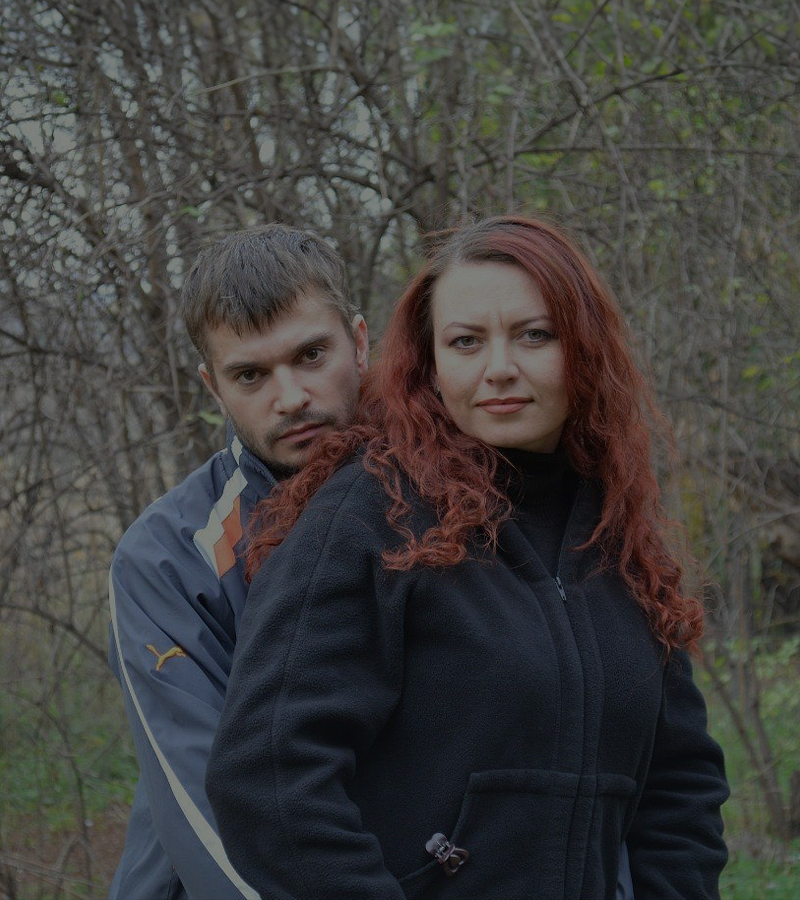Anton Drobovych: “Remembrance is resistance to oblivion”
An interview with scholar and public figure Anton Drobovych for the Museum of Civilian Voices founded by the Rinat Akhmetov Foundation.
The Museum of Civilian Voices founded by the Rinat Akhmetov Foundation — a project that has collected over 130,000 testimonies — is conducting a series of interviews to explore the future of documenting and archiving war-related data.
As part of this series, a public conversation took place with scholar, public figure, and head of the Center for Human Rights and War Memorialization at the Kyiv School of Economics, Anton Drobovych. The theme of the conversation was: “How can we preserve the truth about an ongoing war? The idea of a National Repository (Archive) of Documents.”
The interview touched on various aspects of preserving testimonies about russia’s war against Ukraine, emphasizing the risks that this could become not only the most documented war, but also the most discredited one.
The impetus for organizing this conversation came from Anton Drobovych’s article published in Ukrainska Pravda, titled “The Challenges of Documenting the War: How to Protect Facts from Becoming ‘Fakes’?” The piece sparked lively debate on social media.
The interview was moderated by Nataliya Yemchenko, Director of Communications at System Capital Management and a member of the Supervisory Board of the Rinat Akhmetov Foundation.
Nataliya Yemchenko: Today, an incredible number of testimonies about the war have been recorded. What should be done with them next?
Anton Drobovych: To begin with, a few words about the broader ecosystem. Ukraine has been at war for more than ten years now. That’s over a decade of fierce resistance — through direct combat, support for the armed forces, civil resistance in temporarily occupied territories, and more. One of the most subtle, invisible, and often overlooked forms of resistance is resistance to oblivion. Many people are deeply affected by the thought that, in the future, others might not know what truly happened here.
I was personally shocked by stories, particularly from Mariupol, where — under siege, under Russian shelling, and desperately trying to evacuate — people still found a way to mark the location of an improvised grave in front of an apartment building where their neighbors had been buried.
Nataliya Yemchenko: And then they drew maps to help others locate these burial sites.
Anton Drobovych: Yes, and after evacuating, they passed this information on to the authorities or the military.
In other words, there are many layers to recording the truth about the war — from personal acts to large-scale systemic projects. However, some initiatives involved in documentation are being shut down, while others are being repurposed. And it’s crucial for society to understand what to do in this situation.
In my opinion, the focus should be on what helps us survive and remain effective. This is about maximum solidarity and mutual support — including from the state. It’s also essential to consolidate the efforts of both governmental and non-governmental actors to create a structured format for preserving information.
Nataliya Yemchenko: Why not create this format immediately within the framework of state institutions? Why is a preliminary dialogue necessary?
Anton Drobovych: Of course, everything can be established right away based on state institutions — but there are some nuances. Among them is a certain degree of doubt about the state’s effectiveness in this matter. There are various reasons for this, and I’ll mention just one.
These days, we often hear statements that humanitarian policy, identity, and culture are matters of national security. At the same time, actual attention to these areas — that is, funding — is decreasing. This is also noticeable in the field of archiving and documentation.
As a result, we see mutual criticism. Toward the state: If you’re funding it at this level, how will you protect these collections and testimonies? And what guarantees are there that, for such a low salary, you won’t end up hiring an FSB agent who will discredit or manipulate the information? The state, in turn, emphasizes that private or civil society organizations bear no formal responsibility and can disappear at any moment.
Nataliya Yemchenko: It’s clear that right now, the state is directing all its resources toward defense. Still, what kind of funding are we talking about?
Anton Drobovych: To develop a proper state strategy for documenting the war, what’s needed is not so much resources as vision, honesty, and a regulatory framework — in other words, clear rules of the game for the community.
Nataliya Yemchenko: And who is the owner — the responsible party — on the part of the state? Who should implement this strategy?
Anton Drobovych: According to the logic of regulatory documents, it should be one of five ministries: the Ministry of Justice, the Ministry for Communities and Territories Development of Ukraine, the Ministry of National Unity, the Ministry of Culture and Strategic Communications, or the Ministry of Social Policy.
These are the institutions that should be involved in implementing transitional justice legislation. This is a legal concept aimed at overcoming situations of extreme violence, such as war. It encompasses lustration, reparations, confirmation of benefits, restoration of legal statuses, the right to truth, and other very practical issues that require documentary evidence.
So, the issue is not about funding — it’s about defining: “This is the government body responsible for this story.”
.jpg)
Nataliya Yemchenko: And this has not yet been defined.
Anton Drobovych: Yes, there are only scattered, isolated elements — a number of narrowly focused strategies developed by the archival service, the Institute of National Memory, the Ministry of Culture and Strategic Communications, and others.
At the same time, dozens of private foundations, civic and human rights organizations operate in parallel: they record russian inscriptions on walls, maps of combat operations, and collect people’s stories — when, who, where they were, and who died.
There is also primary documentation — documents created during witness interviews. Once all testimonies are used in tribunals, the documents will be archived for preservation. According to statistics from the Office of the Prosecutor General, as of today, 160,000 cases have been opened regarding war crimes.
Nataliya Yemchenko: There is also a vast amount of works that are documentary in nature, in which people describe their personal experiences of the war.
Anton Drobovych: Yes. This includes, for example, Katya Savenko’s diary, which is an egodocument. Also a veteran’s poetry book, and paintings. For instance, artist Mykyta Kadan has a canvas titled “Shchekavytsia,” and the title is quite telling. Such a painting wouldn’t have appeared in peaceful bohemian times, or it would have had a completely different meaning. In this case, art also documented the experience lived through.
Or at the Museum of Civilian Voices, you recorded the experience of a person who just left a temporarily occupied territory. Meanwhile, someone else listened to this interview, analyzed reports and photo reports from the scene, and conducted a study on the occupiers’ strategy in the temporarily occupied territories. This, too, is a document of the era — but synthetic or reflective in nature.
Nataliya Yemchenko: Which areas of documentation should the state be 100% responsible for?
Anton Drobovych: The state will always retain at least two monopolies: criminal prosecution and the creation of damage registries. There is also policy regarding the enforcement of other forms of accountability — primarily administrative.
When it comes to creating a war repository or archive, there are two possible scenarios.
The first is a state-based approach involving partnerships with civil society and other actors.
The second: private actors, universities, civil society, or even businesses could organize a consortium to create this entity, establish its rules of operation, and invite the state to cooperate.
So far, both scenarios are equally viable. The question is who will be able to build the system, take responsibility, and ensure effective communication.
Our future is at stake — in the very sense that motivated the person in Mariupol to erect an improvised monument to their fallen neighbors. If we build such a place, then in 100 years we will have an understanding of what really happened. If not...
This year, the Russian Federation allocated $500 million for propaganda. Here’s the question: How much truth about our time will remain if they annually invest $500 million to distort, buy off, erase, and discredit it? Meanwhile, the number of those documenting, preserving, and so forth is steadily decreasing each year on our side. I believe that in 10 years, we will face a dramatic situation, and what is now the most documented war will become the most compromised one.
Nataliya Yemchenko: The conversation about creating the repository is shifting from theoretical to very practical. What is the timeline we’re looking at?
Anton Drobovych: If we don’t have at least a project underway next year, that would be a very dangerous situation. In fact, this conversation is a stimulus for all actors, including the state, to get involved in the process.
Nataliya Yemchenko: The Museum of Civilian Voices founded by the Rinat Akhmetov Foundation has collected over 130,000 stories. As an institution, we don’t yet have a clear vision of “what to do next” with this material, but there is a demand for such understanding to emerge.
Anton Drobovych: That is a very healthy request coming from a practitioner. And there are many such requests within the system already.
At the beginning of our conversation, I spoke about solidarity. It is extremely important now to demonstrate it in order to preserve what has already been collected. For example, a larger organization could help a smaller one by providing servers or at least taking registers into custody.
I also want to emphasize the issue of data vulnerability. Let me give an extreme example.
In 2014, the russians shot down the MH17 plane over Donbas. Thanks to a photo taken by a civilian that captured the rocket launch trail, investigators were able to reconstruct details — where it was launched from, who controlled the territory, and so forth. The problem was that without metadata matching the camera, the photo had no legal weight in court. Security services managed to find the photo’s author and the camera, which gave it significance in the criminal proceedings.
Now, imagine that a reliable photograph is needed 20 years after the event. You find the required shot in a newspaper archive. It is captioned: “Taken from the social network of so-and-so.” But that social network no longer exists. Like Skype, for example, which recently shut down. And all that remains is a screenshot of the photo, without metadata.
Nataliya Yemchenko: A trace from a trace.
Anton Drobovych: Yes. But that’s not all. ChatGPT has recently gained popularity. Will artificial intelligence be able, 20 years from now, to create a photo of better quality than a print screen from today’s media? Undoubtedly! And how do we ensure truth under such conditions? If there is an original photo with metadata, preserved in a trusted repository with state status, that’s one thing. But if it’s only a screenshot, then there is nothing. In other words, we end up in a bubble reality where hyperlinks lead nowhere.
Nataliya Yemchenko: Please describe the idea of a national depositary. Is it a physical space, servers, cloud storage? What should be included there, how many people are needed to manage it, and how much funding is required?
Anton Drobovych: This needs to be an expensive project with a robust security and protection system. It’s clear that this will become another priority target for the enemy — it’s a matter of fighting for reality and the future. Hardware, servers, and storage make up roughly 20% of this undertaking.
Another 20–30% is software: support ecosystems, cloud storage, access management, and so on.
But the most important — and here we return to the topic of cooperation — is the methodology of work: creating catalogs, developing methods, and establishing rules of engagement for the actors who currently store data and have their own systems.
The next-level issue is developing a project management format, where again, protection will be a priority — security, access to personal data, and so forth.
There are also several blocks related to copyrights, protection of sensitive information, and so on. In short, this is a project that is as complex as it is significant for the state.
Nataliya Yemchenko: You mentioned that russia would be interested in destroying it. This is a state with extensive experience in special operations, hybrid warfare, and so on, so we’re talking both about physical destruction and infiltration — through money, experts, and other means. Is it possible to safeguard the archive from Russian influence?
Anton Drobovych: Of course, there are cases where archives are secured. But in this case, the risks are much higher. Therefore, the archive should not be the sole storage location.
In reality, it should function as a service. Some will perceive it as a backup — that is, previously created copies of data to restore originals if lost. The data itself must be cryptographically protected — so that it cannot be accessed without a specific procedure.
And for others, it will be the place where access is provided. In other words, there is the server itself, and in another city — a reading room.
For some, it is access to cloud storage with duplicates in various European cities — so that the information is not physically vulnerable.
Nataliya Yemchenko: For us, as players in this field, the question of benchmarks is very important, since there are various expertises worldwide. And more broadly, are there such reference points for Ukraine, considering that our situation is completely unique?
Anton Drobovych: Benchmarks do exist, and we should look everywhere, but develop our own model.
The Shoah Foundation began when Steven Spielberg, as a private individual with a reputable standing, created the foundation — hiring scholars who developed the methodology. They then collected testimonies from all Holocaust survivors in Poland and the former Soviet Union — in-depth interviews with verification questions. Eventually, they created a private archive. Later, all testimonies were transferred to a university for safekeeping.
There are numerous other examples across European countries where memory preservation is managed by libraries, museums, private foundations, the state, or state archives. We need to understand how these operate and choose the optimal approach for us — an idea to which a coalition of concerned practitioners will commit.
This is a very important detail because individuals and organizations that have been collecting and preserving testimonies for years were never asked to do so. They simply felt the need. This is the entry ticket to this story.
***
At the Museum of the History of Kyiv, an exhibition titled “Diaries of Civilians: Voices of Those Who Survived and Those Who Did Not” is currently on display. This is a documentary project of the Museum of Civilian Voices founded by the Rinat Akhmetov Foundation, which collects and preserves the world’s largest collection of testimonies about the war in Ukraine. To date, the Museum has gathered over 130,000 stories.






.png)



